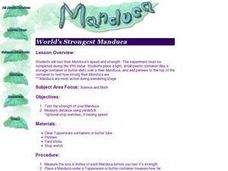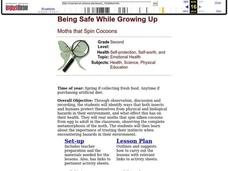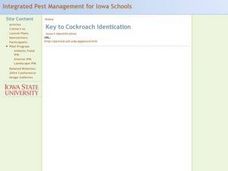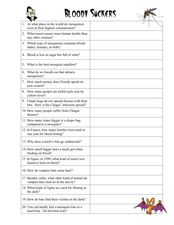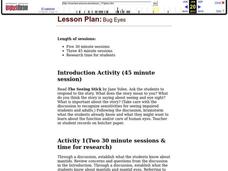Curated OER
World's Strongest Manduca
Young scholars test the strength and speed of their Manduca. They keep their insect in a small dish and wiegh it down with pennies. They share their observations with the class.
Curated OER
Totally Termites
Students explore the world of termites, their adaptations, and anatomy. They examine the property risks of termites and how pest control professionals manage termite problems.
Curated OER
"Ladybugs and Grasshoppers"
Students paricipate in number of activities related to ladybugs and grasshoppers.
Curated OER
Body Parts of a Butterfly
Students identify the seven major parts of a butterfly. In this butterfly anatomy lesson, students explore three dimensional models of butterflies and discuss the anatomy. Students view a PowerPoint for the anatomical parts of a...
Curated OER
Butterfly Report
In this biology worksheet, students draw or trace an accurate picture of a butterfly. Then they complete the information related to their butterfly's classification and list the habitats where they are likely to be found. Students also...
Curated OER
Our Forest is Changing
Students read a story and solve a problem about an unhealthy population of trees. In this forest lesson students study tree disease and then research it online and present what they found.
Curated OER
Just Spray 'Em!?
Students read the label of an insecticide and identify pertinent information. They tell that the higher the LD50 the less toxic the chemical. Students begin to extrapolate the impact of pesticide use beyond the death of the insect.
Curated OER
Head, Shoulders, Knees & Toes
Students, through observation of crickets, recognize and use proper names for human and insect body parts. They compare and contrast parts of human and insect body parts.
Curated OER
Design a Pollinator
Learners make a scientific drawing of a pollinator with at least five traits that make them well adapted to a given plant(s). They describe in their science notebook the adaptations that make their pollinator well suited to a given plant.
Curated OER
Bug Hunt
Students strengthen observational skills by searching for insects in their home and classroom. In this observation lesson, students use magnifying glasses to classify what kinds of bugs were found. Students then create a bar graph to...
Curated OER
Being Safe While Growing Up
Second graders identify ways that both insects and humans protect themselves from physical and biological hazards in their environment. They rear moths from egg to adult and consider the importance of trusting their own instincts.
Curated OER
Africanized Honey Bees And The Press
Students investigate how honey bees and other insects are portrayed in the press. read the articles and compare and contrast the tone of each article. Have students create a list of the verbs used in each article and assess the overall...
Curated OER
Environment: Insects and Pesticides
Students classify bugs as pest or non-pests and identify ways to control them. They also examine the three levels of pesticides by reading the labels. Students complete charts of signal words on pesticide labels.
Curated OER
Plants 'n' Bugs
Second graders experiment to find if pollinators have color preferences. For this plant and bug lesson, 2nd graders gather information about how flowers pollinate. Students participate in a pollination experiment using the scientific...
Curated OER
Locating Echo
Students read the book The Adventure of Echo the Bat. For this animal science lesson, students read the book and create a chart labeled "Land Feature," "Habitat," and "Food." Students fill in the table according to where the character...
Curated OER
Soil Composition
Students examine soil. In this soil composition lesson students participate in soil sedimentation and filtration activities. The students discuss what non-living and living things are in soil and why it is so important.
Curated OER
Washing Germs Away
Students investigate germs. In this cross curriculum health and biology lesson plan, students listen to Old Black Fly by Jim Aylesworth and identify ways in which flies spread germs. Students discuss hand washing during a visit by the...
Curated OER
Building A Bug Bungalow
Learners chart how milkweed bugs grow and change. In this growth and life stages activity, students read two stories and discuss how and why things grow. Learners brainstorm what can be measured about humans, review and discuss life...
Curated OER
Parts of the Flower and Pollination
Learners review the parts of the plant and recognize the parts that are important for pollination. In this pollination instructional activity, students illustrate and label the parts of a flower. Learners compare different types of...
Curated OER
Environmental Problems and Solutions
In this environmental problems and solutions worksheet, students are given a list of 25 environmental problems. They match them with a given solution and paste the matching pairs to a piece of construction paper.
Curated OER
Bloody Suckers
In this blood sucking animals worksheet, students answer 20 questions about leeches, mosquitoes, Chepo bugs, and bats which all suck blood to transmit diseases or get nutrients.
Curated OER
Co-evolution of Plants and Pollinators
Young scholars explore biological evolution and natural selection and its evolutionary consequences. They also explore how organisms are interdependent on one another.
Curated OER
Bug Eyes
Students explore mantid eyes and human eyes. In this mantid eyes and human eyes research lesson, students work in small groups to gather information. Students read books, observe mantids, and do experiments. Students then present their...
Curated OER
Into the Bat Cave
Students explore the lives of bats. In this bat lesson plan, students participate in up 6 activities that focus on bats and build their background knowledge about the nocturnal mammals.
Other popular searches
- Insects Science
- K 2 Life Science Insects
- Parts of Insects Science
- Life Science Insects
- Esl Lessons Science Insects
- Esl Science Insects


